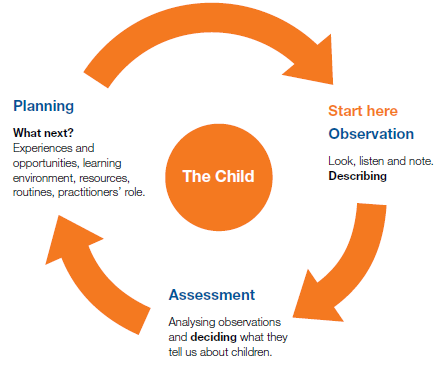The Early Years Foundation Stage (EYFS) (DfE, 2012) clearly states how early years providers must ensure that the Statutory Framework is embed into everyday practice which allows children to learn and develop.
In regard to planning this should reflect on the different ways children learn and develop, practitioners practice should also demonstrate their level of understanding of how children learn and develop. Within the EYFS there are three characteristics of effective teaching and learning, these have been added to highlight that children can achieve any one of these types of learning at any age, they support children’s learning across the whole EYFS and gives practitioners a more clear focus of what children may be achieving aswell as the development matters.
The three characteristics of effective teaching and learning are:
- playing and exploring – children investigate and experience things, and ‘have a go’;
- active learning – children concentrate and keep on trying if they encounter difficulties, and enjoy achievements; and
- creating and thinking critically – children have and develop their own ideas, make links between ideas, and develop strategies for doing things.
For more information on the characteristics of effective teaching and learning CLICK HERE
The EYFS also concentrates on the prime and specific Areas of Learning and Development, these also interconnect with the Characteristics of Effective Learning
as stated in the EYFS development matters;
- The prime areas begin to develop quickly in response to relationships and experiences, and run through and support learning in all other areas. The prime areas continue to be fundamental throughout the EYFS.
and
- The specific areas include essential skills and knowledge. They grow out of the prime areas, and provide important contexts for learning.
- Prime areas are fundamental, work together, and move through to support development in all other areas.
- Personal, Social and Emotional Development
- Communication and Language •
- Physical Development
- Specific areas include essential skills and knowledge for children to participate successfully in society.
- Literacy
- Mathematics
- Understanding the World
- Expressive Arts and Design
Good and effective planning is fundamental to children making high levels of progress and incorporating learning through play is key. Short term planning or weekly planning brings together a collection of children’s individual observations, group observations,children’s interest and parents contributions. Having all this information will enable practitioners to identify and plan activities, experiences, and children’s next steps for the following week. Planning proformas are different from setting to setting however the principles are still the same. Within the weekly planning some settings have a system whereby the key person will plan for their key children and this is either planning on its own or it is linked into the weekly proforma.
The EYFS talks about long term and medium term planning and again this is implemented into settings in different ways. The long term planning may be looking at the learning opportunities for the whole year this may include setting up the learning environment indoor and outdoor, organising areas of provision deciding on core equipment , decisions about regular routines and devising a strategy to ensure coverage of the seven areas of learning and development. This can be challenging as planning should be adaptable and not planned months in advance, having this in mind some settings look closely at their areas of provision both indoors and outdoors and regular monitor and evaluate these, this allows practitioner to enhance the areas based on the children s interest and adapt that environment accordingly. For more help and advice on carrying out planning and types of planning speak to your local advisory team.
Here are some examples of how some settings and local County Councils carry out their planning
City of york Children’s Centre – baby room planning 0-11 months
City of york Children’s Centre- Toddler room planning 8-20 months
City of york Children’s Centre – Toddler room planning 16-26 months
For examples of their planning proforma’s CLICK HERE
Wigan County Council- weekly planning
Wigan County Council – next steps planning
For examples of their planning proforma’s CLICK HERE
East Riding of Yorkshire- Continuous provision planning
East Riding of Yorkshire- Weekly planning
East Riding of Yorkshire- Medium Term planning
East Riding of Yorkshire- Next Steps Planning
For examples of their planning proforma’s CLICK HERE

